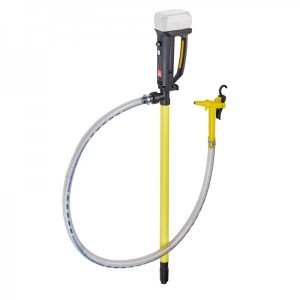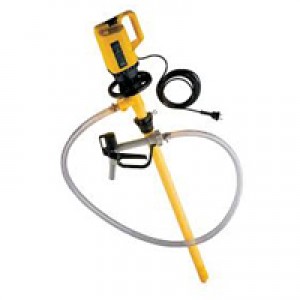Category: Drum Pumps
Lutz offers integrated solutions. Whether you want a whole set or a tailored unit, Lutz has solutions for you. A compatible accessory set ensures efficient and safe operation in all areas of application. The most important factor is operational safety. Lutz pumps have been tested and approved to meet established norms and directions. They meet all of the standards established by ATEX, UL, PTB, VDE, and CE. A strong hold on the future. With Lutz pumps, you can be mobile and adaptable to your changing needs.
If you can’t find the item you’re looking for, please email us at: [email protected]
Drum pumps are specialized devices used to transfer liquids from barrels, drums, or containers safely and efficiently. These pumps are designed to handle a variety of fluids, including water, chemicals, oils, and other viscous substances, making them essential tools for industrial, commercial, and laboratory applications. By using a drum pump, operators can quickly dispense liquids while minimizing spillage, reducing manual labor, and increasing workplace safety.
What Are Drum Pumps and How Do They Work?
Drum pumps consist of a tube that fits into the opening of a drum or barrel, with a pumping mechanism that draws out the liquid. The mechanism can be manually operated, powered by electricity, or driven by air, depending on the model and application requirements.
Key Components of a Drum Pump
- Pump Tube: The long tube extends into the drum, reaching the liquid at the bottom.
- Motor or Manual Handle: Drum pumps can be operated by turning a handle, using an electric motor, or connecting to a pneumatic system.
- Discharge Nozzle: This component controls the flow of the liquid being dispensed, ensuring precision and preventing spillage.
Benefits of Using Drum Pumps
Increased Efficiency and Speed
Drum pumps allow for quick and controlled transfer of liquids from drums, saving time and reducing the manual effort required to tilt or pour heavy containers.
Enhanced Safety
Manually lifting or tipping heavy drums can lead to spills and injuries. Drum pumps eliminate these hazards by allowing liquids to be transferred safely and easily.
Precise Dispensing
Many drum pumps come with flow control features, allowing users to accurately dispense liquids, which is particularly important for chemical dosing or handling costly fluids.
Compatibility with Various Fluids
Drum pumps can be made from materials like stainless steel, polypropylene, and PTFE, making them compatible with a wide range of liquids, including corrosive chemicals, oils, and viscous solutions.
Types of Drum Pumps
Electric Drum Pumps
Electric drum pumps are powered by an electric motor and are ideal for high-volume transfer tasks. They offer fast, consistent flow rates and are suitable for handling both low and high-viscosity fluids.
Pneumatic Drum Pumps
Pneumatic or air-driven drum pumps use compressed air to move the fluid. These pumps are ideal for use in environments where electrical sparks could pose a risk, such as flammable liquids and hazardous locations.
Manual Drum Pumps
Manual drum pumps require no external power source and are operated using a hand lever or rotary handle. These pumps are cost-effective solutions for low-volume or occasional fluid transfers.
Applications of Drum Pumps
Chemical and Industrial Processes
Drum pumps are widely used in chemical processing, manufacturing, and industrial facilities for transferring acids, bases, solvents, and other chemicals from drums to process tanks or equipment.
Oil and Lubricants Dispensing
In automotive, aviation, and industrial maintenance applications, drum pumps efficiently transfer oils, greases, and lubricants from storage containers to equipment or machinery.
Food and Beverage Industry
Drum pumps made from food-grade materials are used for transferring liquids like syrups, juices, and food additives, ensuring hygiene and precision in food processing applications.
Laboratories and Pharmaceuticals
In lab settings, drum pumps provide a safe and precise way to handle small quantities of chemicals or pharmaceutical solutions, reducing contamination risks.
Choosing the Right Drum Pump
Material Compatibility
Selecting a pump material compatible with the fluid being handled is critical. For corrosive chemicals, polypropylene or stainless steel pumps may be required, while general-purpose applications may use other materials.
Flow Rate and Viscosity Handling
Consider the viscosity of the fluid and the required flow rate. High-viscosity fluids may need a more powerful electric or pneumatic pump, while low-viscosity fluids may work well with manual pumps.
Power Source
Evaluate the availability of electrical or compressed air power at the operation site. Electric and pneumatic pumps offer faster flow rates, while manual pumps are better for small, low-frequency transfers.
Maintenance Tips for Drum Pumps
- Clean the Pump Regularly: After each use, thoroughly clean the pump to prevent clogging, corrosion, or cross-contamination between different liquids.
- Inspect for Wear and Damage: Regularly inspect the pump components for wear, cracks, or other damage that may affect performance.
Use the Right Accessories: Ensure you are using the correct nozzles, hoses, and adapters for your specific drum pump to maintain efficiency and safety.




